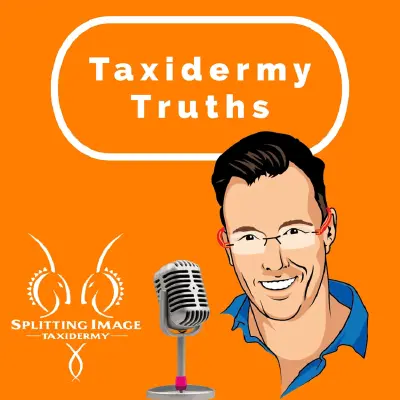
Taxidermy Truths
34 episodes Last Updated: Dec 13, 24
Welcome to Taxidermy Truths, where we discuss the ins and outs of not only the taxidermy process, but the influences on the hunting community as a whole.
With over 25 years in the Wildlife and Taxidermy industry, Douglas Cockcroft hosts open conversations with artists, experts and industry giants.
From sustainable utilization to shipping rates, we dig into the reality of the experience after the safari and hear real stories, Worth Remembering.
Episodes
That’s a wrap.
In the final episode of Taxidermy Truths for 2024, Doug discusses the Year in Review.
We look back on what has been an incredible year for our industry - giving insights, reflections and hopes for the future.
Thank you for your amazing support for the podcast – we look forward to sharing more Taxidermy Truths in 2025.
In order to create taxidermy that is anatomically correct, you need to be able to stretch the skin. Tanning replaces the fats, oils and moisture from the skin and takes it to a stable state, leaving it pliable, soft and able to stretch.
In this episode of Taxidermy Truths, Doug discusses the tanning process, and some of the science behind the solutions. He gives some insight into the tanning for taxidermy process and provides aspects to consider when it comes to tanning for leather.
Listen to the full episode to understand how to create the best canvas for great taxidermy.
This week on Taxidermy Truths, we discuss skinning for different mount types.
Whether you are considering a shoulder mount, pedestal, half mount, 3D mount or full mount – each display requires different instructions for skinning your animal. Then there are also the rug mounts, flat skins and backskins to think about.
Planning your taxidermy along with your safari is a great way to ensure that your animals are skinned according to your requirements.
Doug gives some useful tips and information on how to skin correctly for each mount type and the factors to consider ahead of time.
Doug recently sat down with Dylan Love of PH Journals, to have an open discussion about the role of commissions in the hunting and taxidermy industry.
They also discuss shipping, the client experience, relationships and ethical principles.
Without the hunting industry in South Africa, our wildlife would and our economy would lose value. It’s important that we stand shoulder to shoulder to keep moving forward – listen to the full episode to learn more.
Shipping your trophies shouldn’t be scary.
In this episode of Taxidermy Truths, Doug unpacks the shipping process and explains the relationship between all parties involved in getting your trophies from the taxidermist to your home.
We speak about the pros and cons of ocean vs airfreight, how shipping rates are calculated and important steps to take to ensure simple and efficient passage of your trophies to final destination.
If you’re exporting trophies from South Africa – you don’t want to miss this.
In this episode of Taxidermy Truths, we are talking all things Replicas.
Doug sits down with Sjoerd Leistra, a master mold maker and fine artist.
They discuss the various techniques involved in creating hyper-realistic replica skulls and various other pieces used in the Taxidermy process. This fascinating artform combines age-old methodology and the latest 3D technology to create incredible reproductions.
Replicas are lightweight, require no permits and allow hunters the freedom to both display their skulls and create a taxidermy piece.
Listen to this interesting discussion to learn more.
The real cost of taxidermy to a hunter is the investment into a quality piece of art that you can be proud of. As hunters, we need to ask: Do I invest in this experience that I cannot get back, or do I risk a cheap deal?
Quality work comes at a cost, but taxidermists should provide value for money to hunters.
In this episode of Taxidermy Truths, Doug unpacks the importance of considering the quality and service of taxidermy projects, and what to look out for to prevent disappointment.
Sep 06, 2024
Taxidermy Truths | Episode 26 | Colours Variants
If you’ve hunted a Black Impala, Copper Springbuck or Golden Wildebeest, then you know about the array of colour variants and the diversity on offer in African game.
While a contentious topic for some, there is no denying that these variations entice hunters to invest in our wildlife and pursue adventures in South Africa.
In this week’s episode of Taxidermy Truths, Doug discusses various examples and collections of colour variants, how they come into being and the impact they have on our industry.
The Tiny Ten is one of Africa’s most spectacular collections of wildlife.
These animals may be small in stature, but Tiny Ten hunting is extremely challenging. You are exposed to a variety of environments and the target is small, agile and very aware.
In this episode of Taxidermy Truths, Doug discusses the Tiny Ten experience and gives some insight into what it’s like to take on the challenge, tips on planning your hunt and advice for presentation of your trophies.
This collection of animals is all about the hunting experience.
Listen to the full episode on Podbean, Apple Podcasts or YouTube.
Women in Wildlife
Today we celebrate Women’s Day in South Africa.
So, for this week’s episode of Taxidermy Truths, we thought it was only fitting to chat to one of the most influential women in the hunting and wildlife industry in South Africa - Adri-Kitshoff Botha.
Doug chats to her about her incredible career, some of her most memorable personal hunting experiences, and advice for those looking to enter the industry.
Adri is certainly someone we can all look up to and learn from, and we know you will enjoy listening to her story.